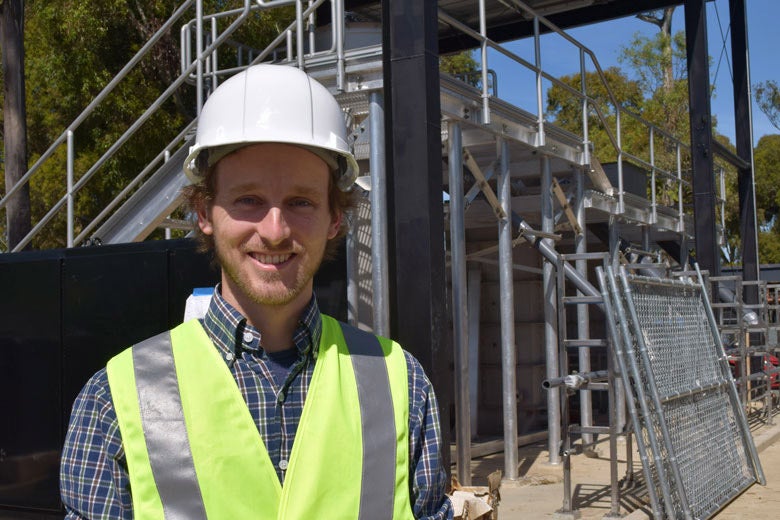
Sebastien Tilmans is operations director of the William and Cloy Codiga Resource Recovery Center, which is set to open in May. (Image credit: Kate Chesley)
This May, Stanford will open the William and Cloy Codiga Resource Recovery Center (CR2C), which is designed to test and accelerate the commercialization of promising technologies for the recovery of clean water and energy from wastewater.
The center, located at the end of Bonair Siding near the Stanford Federal Credit Union, is a collaborative effort among water resource researchers from the School of Engineering and the Stanford Woods Institute for the Environment and water management specialists from the university’s Department of Sustainability and Energy Management. Its humble appearance – it resembles an Erector Set of pipes and pumps – belies its mission to dramatically change the way we think about wastewater treatment and recovery.
“We know this is a transformational moment in our sector,” said Sebastien Tilmans, CR2C operations director. Tilmans earned his PhD in civil and environmental engineering at Stanford and worked at the San Francisco Public Utility Commission’s Oceanside Wastewater Treatment Plant. He was enticed by CR2C faculty director and civil and environmental engineering Professor Craig Criddle to return to the Farm.
Tilmans believes CR2C can provide a blueprint to help municipalities confront the dual challenges of coping with water shortages while replacing aging wastewater treatment plants built in the 1970s with federal funding from the Clean Water Act. At that time, electricity was cheap, water plentiful, funding easier to access and climate change a distant threat. The center’s work is also applicable to universities, private water and wastewater organizations, and corporations.
Changing the paradigm
“We have a narrow window of opportunity when we can demonstrate the viability of alternatives to the 100-year-old paradigm,” Tilmans said.
Instead of viewing wastewater treatment as a way to eliminate hazardous materials, Tilmans said he hopes the Codiga center will help policymakers see that wastewater treatment can produce energy and water clean enough for irrigation and drinking. The technology exists to make that vision possible, affordable and sustainable. The challenge is proving that what works in a laboratory can be scaled up to work when millions of gallons of water are at stake. No government agency will want to spend millions – or potentially billions – on unproven technology.
That’s where CR2C comes into play. The center, funded by the university and a gift from Stanford alumnus William Codiga and his wife, Cloy, employs several different testing methods that scientists can utilize to design new technology and techniques. For instance, four test beds can accommodate visiting researchers who need access to a sufficient amount of wastewater at different grades to make their studies viable. CR2C provides wastewater drawn from a sewage pipe below Serra Street that leads to the Palo Alto treatment plant.
The facility can also serve researchers – including some at Stanford – who are trying to improve remote sensing and monitoring equipment designed to more efficiently test the quality of water. Finally, the Codiga center will test an anaerobic technology that Tilmans said “achieves what we used to think was impossible.”
Wastewater plants traditionally have relied on aerobic treatment processes, which typically employ oxygen-consuming bacteria to digest the biological waste. Such processes, however, use large amounts of energy and generate considerable biosolids that must be disposed of.
By contrast, CR2C will test an anaerobic process – the Staged Anaerobic Fluidized Bed Membrane Bioreactor – that converts organic material into methane. That methane can, in turn, be used to power the treatment process. Such a system would cost less, use less energy, take up less space, result in fewer biosolids and more effectively remove such stubborn materials as pharmaceuticals and beauty products. The system relies on the creation of a colony of insatiable organisms that, once established, become the perfect biowaste eating machines.
Tilmans, a man with an uncanny knack for analogies, explained, “Think of it like a hog farm. But, instead of pigs, we have bacteria.”
National network
When CR2C opens, it will be the fourth and largest Staged Anaerobic Fluidized Bed Membrane Bioreactor in the world, and the first time such a system is tested and demonstrated in the Western Hemisphere. The Department of Energy, the Water Environment Research Foundation, the National Science Foundation and the Environmental Protection Agency have created a National Test Bed Facility Network to bring experts at the very few such facilities together to collaborate. CR2C is a Level 4 test-bed facility, meaning that it is a fully staffed facility dedicated to testing and demonstrating new technologies. Tilmans is looking forward to the first gathering in May.
Tilmans’ vision for the center includes additional facilities that would expand Codiga’s reach into technologies for processing other organic wastes and producing safe, sustainable materials like biodegradable plastics. He also imagines classroom facilities that will teach the next generation of wastewater engineers how to create and maintain sustainable treatment processes. He also hopes that the work of Codiga researchers will help policymakers evaluate new wastewater treatment technologies for future investment.
Equally important is the partnership with Stanford water experts, who hope the Codiga center can eventually play a role in the university’s long-term sustainable water management plans. Stanford currently relies on the Hetch Hetchy water system for its potable water, while also using groundwater and surface water for much of its non-potable water needs. In the long run, however, as Stanford’s water needs grow with its population and campus development, those sources alone may not meet all demands.